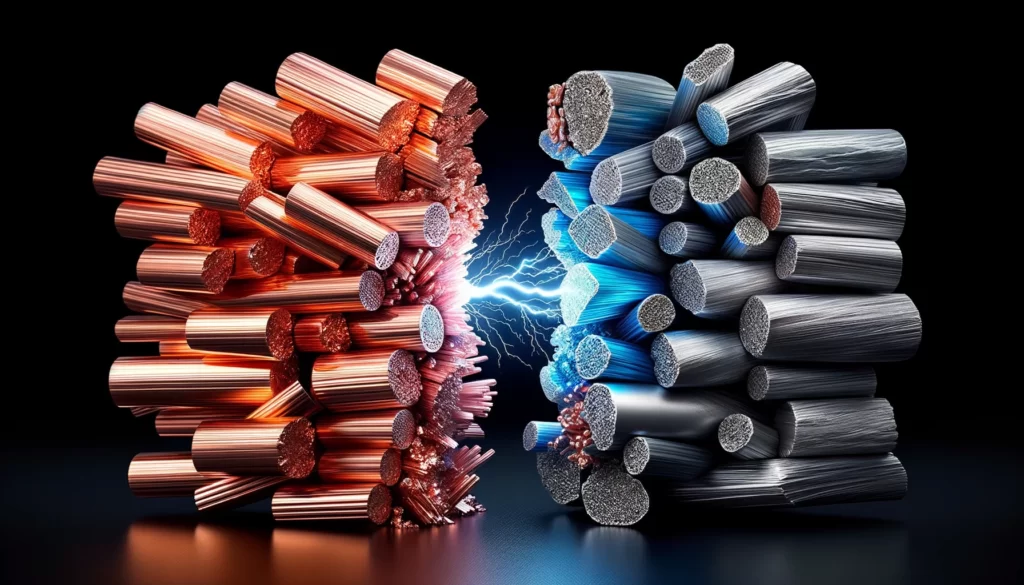When it comes to selecting the right material for busbars in electrical systems, the choice often narrows down to copper and aluminum. Each of these materials has its unique set of advantages that can significantly impact the efficiency, cost, and reliability of the system. This article delves into the distinct features of copper and aluminum busbars, comparing their performance and cost implications to aid in making an informed decision for your project.
Copper busbars are known for their superior electrical conductivity, durability, and ease of installation, making them a reliable choice for high-demand applications. On the other hand, aluminum busbars are lighter and more cost-effective, which might be favorable for projects with budget constraints or weight considerations.
Dive deeper to explore the properties, applications, and industry trends surrounding copper and aluminum busbars. This comprehensive examination will provide a clearer understanding, helping you decide the material that best suits your project’s requirements.

Delving into Copper Busbars
Copper busbars are integral components in a variety of electrical applications due to their excellent conductivity, durability, and reliability. They serve as conduits for electrical currents in systems like switchboards, distribution boards, and substations. Here’s a more in-depth look into copper busbars.
Definition and Properties:
Copper busbars are thick strips or bars of copper, designed to conduct electricity within a switchboard, distribution board, or other electrical apparatus. The superior electrical conductivity of copper, second only to silver, makes it an ideal material for busbars. Besides its conductivity, copper is known for its good thermal conductivity, corrosion resistance, and high tensile strength. It also has a notable ability to withstand overloads and short circuits better than aluminum.
Advantages:
- High Electrical Conductivity: Copper’s electrical conductivity is unrivaled, barring silver, making it highly efficient in minimizing electrical energy losses.
- Thermal Conductivity: Its ability to dissipate heat quickly helps in keeping electrical systems cool, thus ensuring better performance and longer lifespan.
- Durability: Copper is resistant to corrosion and has a high melting point, making it a durable choice for demanding electrical applications.
- Flexibility: Despite its hardness, copper is relatively easy to bend and shape, making it adaptable to various installation requirements.
- Minimal Maintenance: Copper busbars require lesser maintenance compared to aluminum, owing to its resistance to corrosion.
Common Applications:
Copper busbars find extensive use across a multitude of industries and applications. Here are a few notable ones:
- Electrical Distribution Systems: They are crucial in distributing electrical power efficiently across various components and systems.
- Switchgear and Control Panels: Copper busbars are preferred in these applications due to their ability to handle high electrical loads.
- Transformers and Rectifiers: Their efficiency in electrical conduction makes them indispensable in these critical electrical equipment.
- Industrial Furnaces: The high melting point and efficient heat dissipation make copper busbars ideal for use in industrial furnaces.
Industry Standards:
Various international standards govern the manufacturing and application of copper busbars. Some notable ones include ASTM B187/B187M for copper busbar material specifications and IEC 60439 for low-voltage switchgear and controlgear assemblies. Adhering to these standards ensures the reliability, safety, and efficiency of copper busbars in electrical systems.

Uncovering Aluminum Busbars
Just like their copper counterparts, aluminum busbars play a crucial role in conducting electricity across a range of electrical systems. While they may not have the same level of conductivity as copper, aluminum busbars have their unique set of advantages that make them a viable choice in certain applications. Let’s explore the world of aluminum busbars.
Definition and Properties:
Aluminum busbars are essentially strips or bars made of aluminum, designed to conduct electricity within electrical apparatuses such as switchboards, distribution boards, and substations. Aluminum is revered for its lightweight nature, good conductivity, and corrosion resistance, especially when it’s alloyed with other metals or treated. It’s less dense than copper, which makes aluminum busbars lighter and easier to handle.
Advantages:
- Lightweight: Aluminum is significantly lighter than copper, which can be beneficial in applications where weight is a concern.
- Cost-Effectiveness: Generally, aluminum is less expensive than copper, making it a cost-effective option for large-scale electrical installations.
- Good Conductivity: While not as conductive as copper, aluminum still offers respectable electrical conductivity suitable for many applications.
- Corrosion Resistance: When exposed to air, aluminum forms a thin oxide layer that helps protect it from corrosion.
- Ease of Fabrication: Aluminum can be extruded, cast, or forged into desired shapes relatively easily, which can simplify the manufacturing process.
Common Applications:
Aluminum busbars are used in a variety of settings, including:
- Electrical Distribution Systems: They distribute electrical power in both residential and commercial setups, especially where weight and cost are significant considerations.
- Renewable Energy Systems: In solar and wind energy setups, the lightweight nature of aluminum can be an advantage.
- High Voltage Direct Current (HVDC) Systems: Aluminum’s cost-effectiveness makes it a suitable choice for high voltage applications where large amounts of metal are required.
Industry Standards:
Similar to copper busbars, aluminum busbars are also governed by various international standards like ASTM B236 for aluminum and aluminum-alloy bars, rods, and shapes for electrical purposes, and IEC 61439 for low-voltage switchgear and controlgear assemblies. These standards ensure that aluminum busbars meet the requisite safety and performance criteria crucial for reliable electrical installations.

Copper vs Aluminum: A Comprehensive Comparison
When it comes to selecting the right material for busbars, both copper and aluminum emerge as strong contenders. However, the choice between the two largely depends on the specific needs of a project. Below is a detailed comparison based on electrical conductivity, durability, and cost, which can guide you in making an informed decision.
Electrical Conductivity and Efficiency:
- Copper:
- Copper stands out for its superior electrical conductivity. It’s one of the best conductors of electricity, surpassed only by silver.
- The high conductivity of copper ensures less energy loss in the form of heat, which translates to higher electrical efficiency.
- Copper busbars can handle higher loads and are capable of transmitting power more efficiently compared to aluminum.
- Aluminum:
- While aluminum’s electrical conductivity is just around 61% of that of copper, it still offers a decent level of conductivity suitable for various applications.
- Due to its lower conductivity, aluminum busbars might need to be larger in size to match the conductivity of a smaller copper busbar.
Durability and Maintenance Considerations:
- Copper:
- Copper busbars are known for their durability and long-lasting nature. They are less prone to corrosion and require minimal maintenance over time.
- The thermal expansion of copper is lower, which means copper busbars are less likely to change shape or size with temperature fluctuations.
- Aluminum:
- Although aluminum is corrosion-resistant, it’s more susceptible to oxidation than copper. The oxide layer, while protective, can cause issues with electrical connections if not properly managed.
- Aluminum has a higher rate of thermal expansion compared to copper, which could potentially lead to loosening of connections over time if not properly accounted for.
Cost Implications: Initial and Long-term:
- Copper:
- The initial cost of copper busbars is typically higher due to the cost of the raw material.
- However, the long-term maintenance costs can be lower due to copper’s durability and efficiency, possibly offsetting the initial investment over time.
- Aluminum:
- Aluminum busbars are more cost-effective initially due to the lower cost of aluminum.
- But the potentially higher maintenance costs and the possible need for larger busbars or additional support to achieve comparable performance to copper could impact the long-term cost-effectiveness.
In conclusion, the choice between copper and aluminum busbars largely hinges on the project’s budget, electrical efficiency requirements, and long-term maintenance considerations. Copper might be a preferable choice for high-efficiency, low-maintenance scenarios, while aluminum could be considered for cost-sensitive projects where weight is a concern.

Industry Perspectives: Preferences and Trends
The choice between copper and aluminum busbars often hinges on industry-specific requirements, budget considerations, and emerging technological advancements. Here’s a glimpse into how different sectors are adopting these materials and how technology is playing a role in shaping these choices.
Adoption Trends in Different Sectors:
- Energy Sector:
- In power generation and distribution setups, copper busbars are often preferred due to their higher electrical conductivity and efficiency, ensuring minimal energy loss during transmission.
- Automotive Industry:
- With the rise of electric vehicles (EVs), the demand for efficient and durable busbar materials has surged. Copper, being a superior conductor, is often the material of choice to ensure optimal performance and longevity of EV power systems.
- Industrial Manufacturing:
- The choice between copper and aluminum can vary. Copper is favored in scenarios demanding high electrical efficiency and durability, while aluminum might be chosen for its cost-effectiveness and lightweight nature, especially in machinery where weight is a critical factor.
- Telecommunications:
- Copper is often favored for its excellent conductivity and reliability, ensuring uninterrupted and efficient power distribution in telecom setups.
- Residential and Commercial Constructions:
- Aluminum busbars are often used in residential and commercial electrical systems due to their cost-effectiveness and adequate performance for general electrical needs.
Technological Advancements Influencing Material Selection:
- Conductivity Enhancement Technologies:
- Advances in material engineering, such as surface treatments and alloying, are bridging the gap between copper and aluminum’s electrical conductivity, enabling more versatile use of aluminum in applications traditionally dominated by copper.
- Corrosion Resistance Innovations:
- Technological advancements in coatings and treatments are enhancing the corrosion resistance of both copper and aluminum busbars, expanding their longevity and reducing maintenance requirements.
- Cost-Reduction Technologies:
- Innovations in manufacturing processes are gradually reducing the cost differential between copper and aluminum, making copper a more financially viable option for a broader range of applications.
- Recycling Technologies:
- With sustainability gaining prominence, the ease of recycling copper and aluminum is also a factor influencing material selection. Both materials are recyclable, but advancements in recycling technologies are making the process more efficient and environmentally friendly.
In summary, both copper and aluminum busbars have their own set of advantages and industry preferences, often shaped by the evolving technological landscape. The continuous advancements in material science and manufacturing technologies are likely to influence the adoption trends of these materials across different sectors in the foreseeable future.

Making an Informed Decision: Factors to Consider
The decision between opting for copper or aluminum busbars should be a well-considered one, dictated by the specific needs of your project. Here are some steps and factors to ponder upon as you make this crucial choice.
Assessing Project Requirements:
- Electrical Conductivity: Determine the level of electrical conductivity your project demands. Copper, with its higher conductivity, might be more suitable for applications requiring efficient power transmission and minimal energy loss.
- Durability: Assess the environment in which the busbars will operate. Copper’s superior durability might be beneficial in corrosive or high-stress environments.
- Weight Concerns: If weight is a crucial factor, aluminum’s lightweight nature could offer significant advantages.
- Thermal Conductivity: Copper has better thermal conductivity, which could be a deciding factor in high-temperature environments.
Evaluating Cost, Performance, and Longevity:
- Initial Costs: Evaluate your budget against the initial costs of copper and aluminum busbars. Aluminum usually comes with a lower upfront cost.
- Long-Term Costs: Consider the long-term costs including maintenance, repairs, and potential energy savings. Copper, though more expensive initially, may offer cost savings over time due to its durability and efficiency.
- Performance Expectations: Align your performance expectations with the material’s capabilities. Ensure the chosen material meets the operational expectations and longevity requirements of your project.
Consulting with Industry Experts:
- Expert Opinions: Seek advice from industry experts or organizations that have dealt with similar projects. Their insights could be invaluable in making an informed decision.
- Industry Standards: Familiarize yourself with the industry standards governing busbar materials in your sector. Compliance with these standards is crucial for a successful project.
- Material Suppliers: Engage with reputable material suppliers and discuss your project requirements. They could provide valuable recommendations on the suitable material for your project based on their experience and expertise.
A comprehensive evaluation considering the above aspects, coupled with expert consultations, can guide you towards making an informed decision that aligns well with your project requirements and long-term operational goals.

Conclusion
In the discourse of copper versus aluminum busbars, the choice hinges on the specific demands of your project. Copper, with its superior electrical conductivity and durability, stands as a robust choice for high-performance applications. It is especially suited where space is limited, or the highest efficiency is required. On the flip side, aluminum presents a cost-effective and lightweight alternative, albeit with a larger footprint for comparable conductivity.
The decision isn’t black and white; it demands a thorough evaluation of your project’s requirements, budget constraints, and long-term operational considerations. It might also be beneficial to consult with industry experts or delve into case studies to understand how similar projects navigated this choice. By aligning the material selection with your project’s goals and the prevailing industry standards, you are better positioned to make an informed decision that contributes to the optimal performance and longevity of your electrical system.


